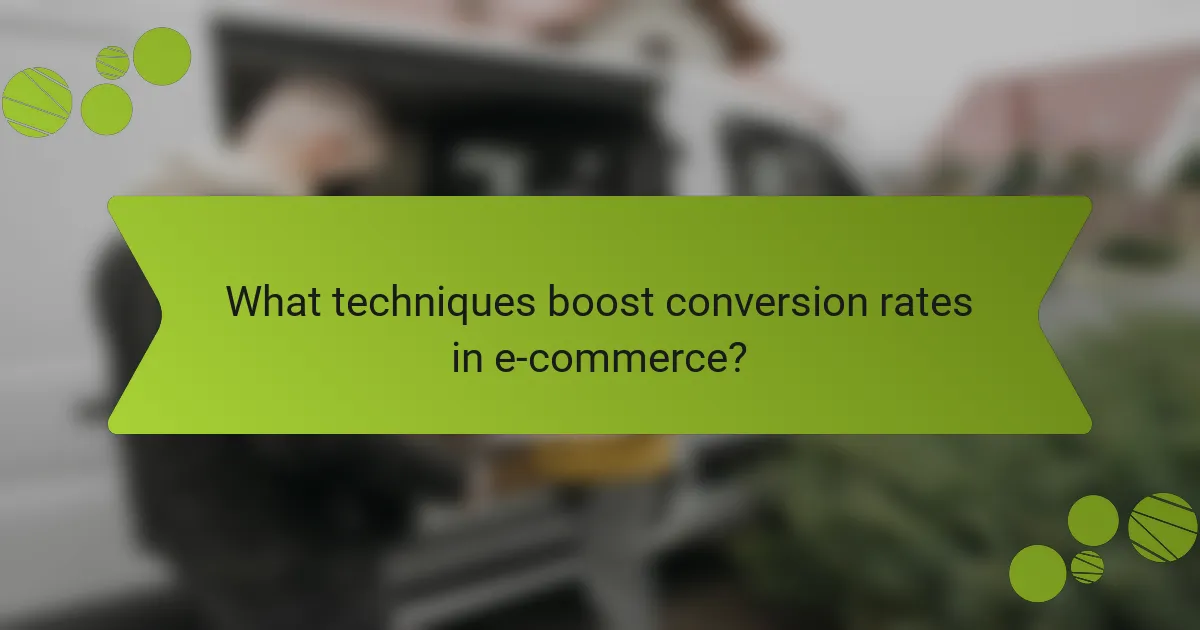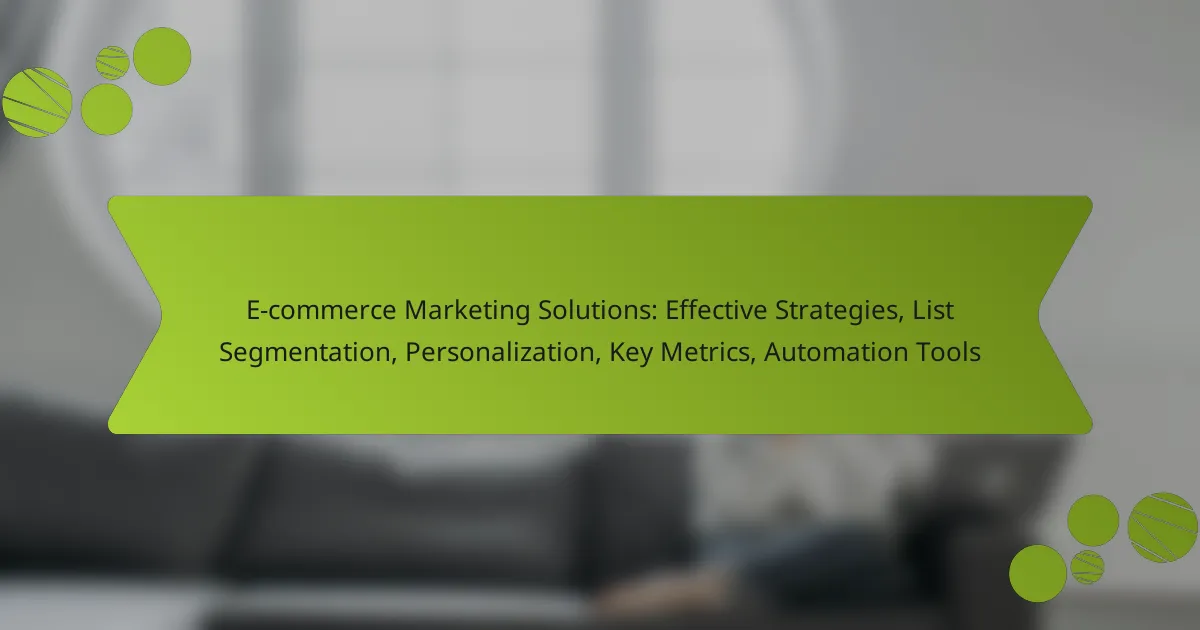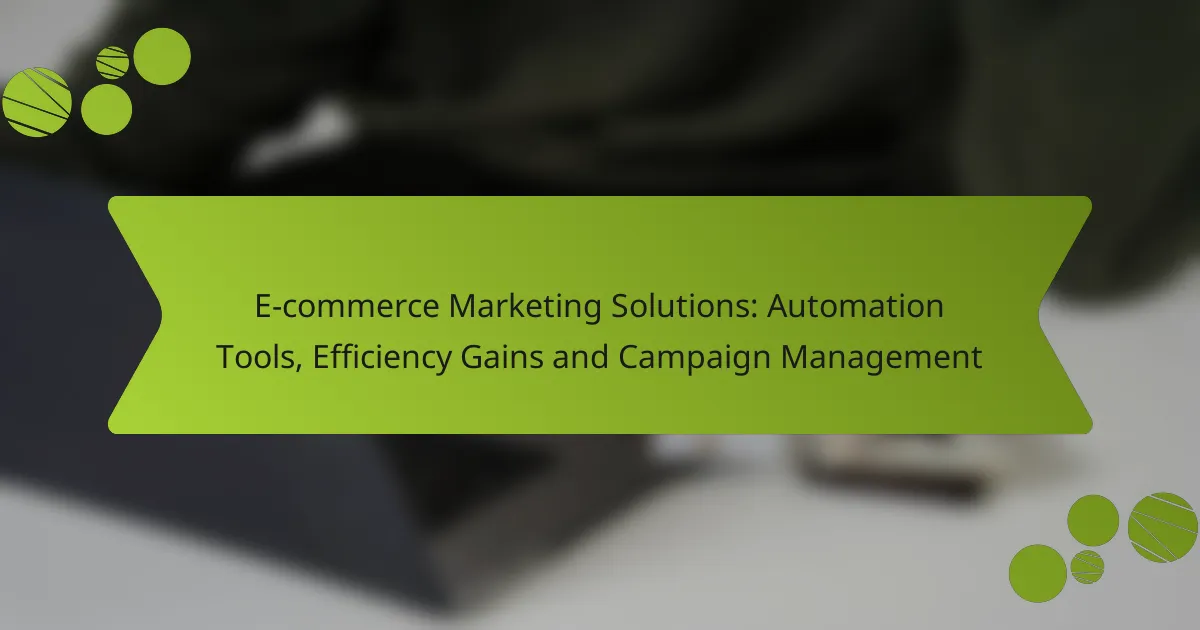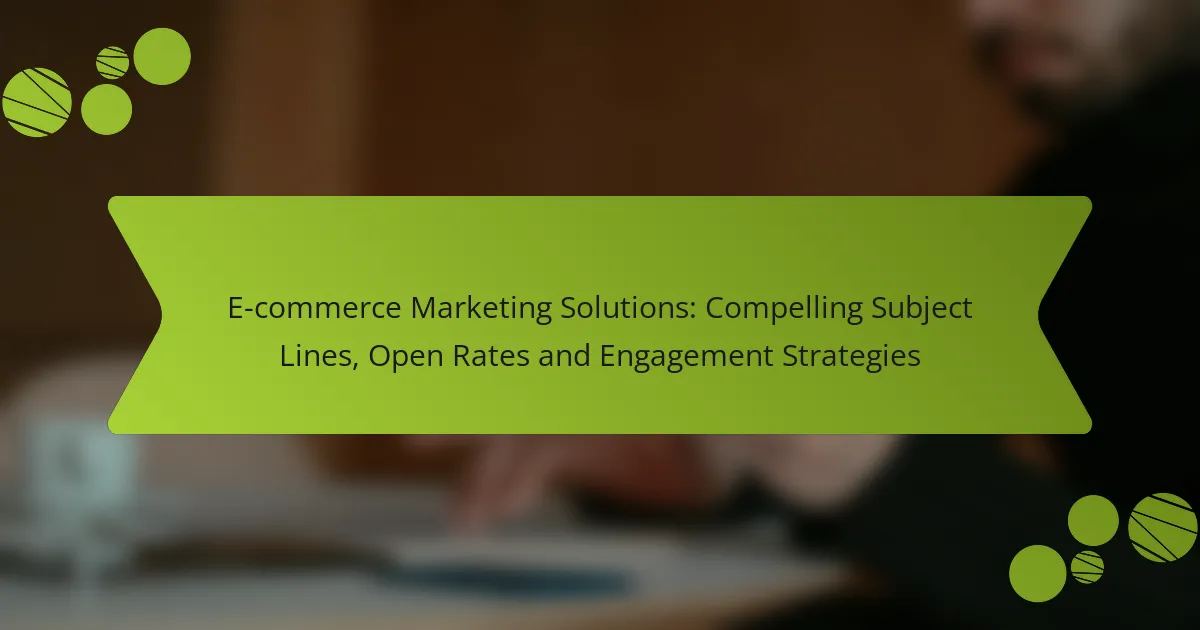In the competitive landscape of e-commerce, effective marketing solutions that prioritize personalization are crucial for enhancing customer engagement and boosting conversion rates. By utilizing techniques such as dynamic product recommendations and personalized landing pages, businesses can create tailored shopping experiences that resonate with individual preferences. This not only fosters stronger connections between brands and customers but also drives higher satisfaction and sales outcomes.

What are effective e-commerce marketing solutions for personalization?
Effective e-commerce marketing solutions for personalization focus on tailoring the shopping experience to individual customer preferences, enhancing engagement and boosting conversion rates. Techniques such as dynamic product recommendations, behavioral email targeting, and personalized landing pages are essential for creating a more relevant and appealing shopping journey.
Dynamic product recommendations
Dynamic product recommendations utilize algorithms to suggest items based on a customer’s browsing and purchasing history. By analyzing user behavior, these systems can present products that align with individual interests, increasing the likelihood of additional sales. For example, if a customer frequently buys athletic gear, the system might recommend complementary items like running shoes or fitness trackers.
To implement effective recommendations, ensure your system is regularly updated with user data and trends. Avoid overwhelming customers with too many suggestions; instead, focus on a curated selection that resonates with their preferences.
Behavioral email targeting
Behavioral email targeting involves sending personalized emails based on user actions, such as abandoned carts or recent purchases. This technique can significantly improve engagement rates by reminding customers of products they showed interest in or suggesting related items. For instance, if a user leaves items in their cart, an email reminder can encourage them to complete the purchase.
To maximize effectiveness, segment your email list based on customer behavior and preferences. Use compelling subject lines and clear calls to action to drive conversions. Regularly analyze open and click-through rates to refine your targeting strategies.
Personalized landing pages
Personalized landing pages are tailored to specific customer segments or individual users, enhancing relevance and improving conversion rates. By customizing content, offers, and visuals based on user data, businesses can create a more engaging experience. For example, a landing page for returning customers might feature exclusive discounts based on their past purchases.
When designing personalized landing pages, consider using A/B testing to determine which elements resonate best with different audiences. Ensure that the messaging aligns with the source of the traffic to maintain consistency and relevance.
AI-driven chatbots
AI-driven chatbots provide real-time assistance to customers, offering personalized support and recommendations. These chatbots can engage users by answering questions, guiding them through the purchasing process, or suggesting products based on their inquiries. For instance, a customer asking about winter jackets can receive tailored options based on their style preferences.
To effectively implement chatbots, ensure they are trained with a comprehensive database of product information and customer queries. Monitor interactions to continually improve the chatbot’s responses and enhance user satisfaction.
Customer segmentation strategies
Customer segmentation strategies involve dividing your audience into distinct groups based on characteristics such as demographics, purchasing behavior, and preferences. This allows for more targeted marketing efforts and personalized experiences. For example, you might segment customers into categories like frequent buyers, seasonal shoppers, or first-time visitors.
To develop effective segmentation, analyze customer data to identify patterns and trends. Tailor your marketing messages and offers to each segment, ensuring that they resonate with the specific needs and interests of those groups. Regularly review and adjust your segments as customer behaviors evolve.

How can personalization improve customer engagement?
Personalization enhances customer engagement by tailoring experiences to individual preferences and behaviors. This approach fosters a deeper connection between the brand and the customer, leading to more meaningful interactions and higher satisfaction levels.
Enhanced user experience
Personalization creates an enhanced user experience by presenting relevant content, products, and recommendations based on individual browsing history and preferences. For example, e-commerce sites often use algorithms to suggest items that complement previous purchases or reflect user interests, making the shopping process smoother and more enjoyable.
To implement effective personalization, businesses should collect data responsibly and ensure compliance with privacy regulations. Utilizing tools like customer relationship management (CRM) systems can help gather insights while respecting user consent.
Increased customer loyalty
When customers feel understood and valued through personalized interactions, their loyalty to a brand increases. Tailored communications, such as personalized emails or loyalty rewards, can significantly enhance the customer experience and encourage repeat purchases.
Brands should focus on creating loyalty programs that reward personalized engagement, such as offering discounts based on past purchases or sending exclusive offers. This strategy not only retains customers but also encourages them to advocate for the brand.
Higher engagement rates
Personalization leads to higher engagement rates by capturing customer attention and encouraging interaction. Personalized marketing messages, such as targeted ads or customized landing pages, can significantly increase click-through rates and conversions.
To maximize engagement, businesses should test different personalization strategies and analyze customer responses. A/B testing can help identify which personalized approaches resonate best with the target audience, allowing for continuous improvement in marketing efforts.

What techniques boost conversion rates in e-commerce?
Several techniques can significantly enhance conversion rates in e-commerce, including streamlined checkout processes, enticing limited-time offers, leveraging social proof, and implementing retargeting ads. By focusing on these strategies, businesses can effectively encourage customers to complete their purchases.
Optimized checkout processes
Optimizing the checkout process is crucial for reducing cart abandonment rates. A seamless, user-friendly experience can include features like guest checkout options, minimal form fields, and multiple payment methods. Aim for a checkout time of under two minutes to keep customers engaged.
Consider implementing progress indicators to show customers how many steps are left. This transparency can reduce anxiety and encourage completion. Avoid unexpected costs at the end of the process, as they can lead to drop-offs.
Limited-time offers
Limited-time offers create a sense of urgency that can drive quick purchasing decisions. These promotions can take the form of discounts, free shipping, or exclusive items available for a short period. A well-placed countdown timer on product pages can enhance this urgency.
When crafting these offers, ensure they are clearly communicated and easy to understand. For example, a 20% discount on a popular item for 48 hours can motivate hesitant buyers to act swiftly. However, avoid overusing this tactic, as it can lead to customer skepticism.
Social proof and reviews
Social proof, such as customer reviews and ratings, plays a significant role in influencing potential buyers. Displaying positive feedback prominently on product pages can build trust and credibility. Aim for a mix of star ratings and written testimonials to provide a well-rounded perspective.
Encourage satisfied customers to leave reviews through follow-up emails or incentives. Highlighting user-generated content on social media can further enhance your brand’s authenticity and appeal. Remember, transparency is key; addressing negative reviews constructively can also enhance trust.
Retargeting ads
Retargeting ads are an effective way to re-engage visitors who have shown interest but did not convert. By displaying targeted ads on social media or other websites they visit, you remind potential customers of their previous interactions with your brand. This technique can significantly increase conversion rates.
To maximize effectiveness, tailor your retargeting ads based on user behavior, such as items viewed or abandoned carts. Use compelling visuals and clear calls to action to entice users back. Monitor performance metrics to refine your strategy and avoid ad fatigue among your audience.

What metrics should be tracked for e-commerce success?
Tracking key metrics is essential for evaluating e-commerce success. Focus on conversion rates, customer lifetime value, cart abandonment rates, and return on ad spend to gain insights into performance and areas for improvement.
Conversion rate
The conversion rate measures the percentage of visitors who complete a desired action, such as making a purchase. A higher conversion rate indicates effective marketing and user experience strategies. Aim for a conversion rate between 1% and 5%, depending on your industry.
To improve conversion rates, consider optimizing your website’s design, enhancing product descriptions, and simplifying the checkout process. A/B testing can help identify which changes lead to better performance.
Customer lifetime value
Customer lifetime value (CLV) estimates the total revenue a business can expect from a single customer over their entire relationship. Understanding CLV helps prioritize customer retention strategies and marketing investments. A typical CLV can range widely, often from hundreds to thousands of dollars.
To increase CLV, focus on building strong customer relationships through personalized marketing, loyalty programs, and excellent customer service. Regularly analyze purchasing patterns to tailor your offerings effectively.
Cart abandonment rate
The cart abandonment rate indicates the percentage of shoppers who add items to their cart but do not complete the purchase. This metric is crucial for identifying barriers in the checkout process. Average cart abandonment rates typically fall between 60% and 80% across various industries.
To reduce cart abandonment, streamline the checkout process, offer guest checkout options, and provide clear shipping information. Sending follow-up emails with reminders or incentives can also encourage customers to finalize their purchases.
Return on ad spend
Return on ad spend (ROAS) measures the revenue generated for every dollar spent on advertising. A higher ROAS indicates more effective ad campaigns. A good benchmark for ROAS is often around 4:1, meaning $4 in revenue for every $1 spent.
To maximize ROAS, focus on targeting the right audience, optimizing ad creatives, and analyzing performance data. Regularly adjusting your ad budget based on campaign performance can help ensure efficient spending and better returns.

What are the prerequisites for implementing personalization?
To effectively implement personalization in e-commerce, businesses need a robust data infrastructure and a clear understanding of their customer segments. This involves collecting relevant data, analyzing it, and applying insights to tailor customer experiences.
Data collection systems
Data collection systems are essential for gathering information about customer behaviors, preferences, and interactions. These systems can include website analytics, customer relationship management (CRM) tools, and feedback forms, which help in building a comprehensive customer profile.
When selecting data collection systems, consider the types of data you need, such as demographic information, purchase history, and browsing behavior. Ensure that your systems comply with relevant regulations, like GDPR in Europe, which governs how personal data is collected and used.
To maximize effectiveness, integrate multiple data sources for a holistic view. For instance, combining website analytics with CRM data can provide deeper insights into customer journeys, enabling more targeted personalization strategies.








